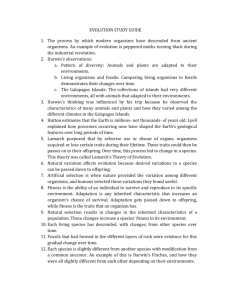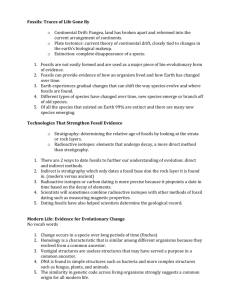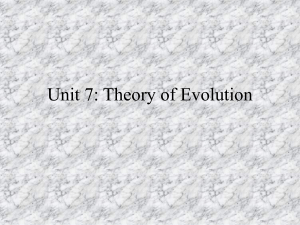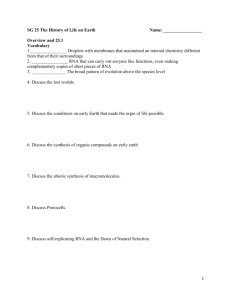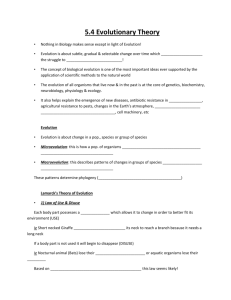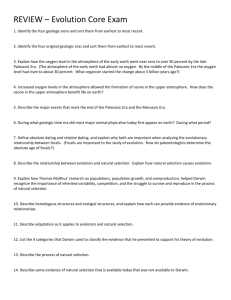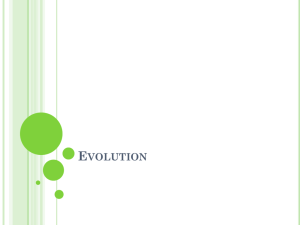Chapter 15 Title
advertisement
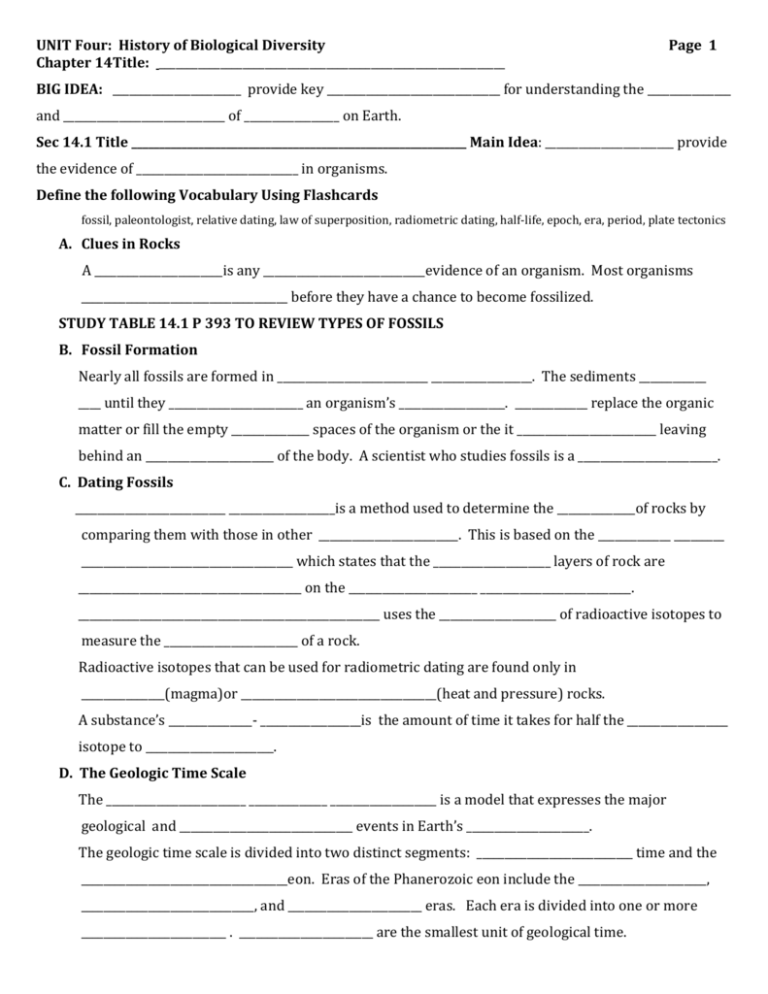
UNIT Four: History of Biological Diversity Chapter 14Title: ______________________________________________________________ Page 1 BIG IDEA: _______________________ provide key _______________________________ for understanding the _______________ and _____________________________ of _________________ on Earth. Sec 14.1 Title ____________________________________________________________ Main Idea: _______________________ provide the evidence of _____________________________ in organisms. Define the following Vocabulary Using Flashcards fossil, paleontologist, relative dating, law of superposition, radiometric dating, half-life, epoch, era, period, plate tectonics A. Clues in Rocks A _______________________is any _____________________________evidence of an organism. Most organisms _____________________________________ before they have a chance to become fossilized. STUDY TABLE 14.1 P 393 TO REVIEW TYPES OF FOSSILS B. Fossil Formation Nearly all fossils are formed in ___________________________ __________________. The sediments ____________ ____ until they ________________________ an organism’s ___________________. _____________ replace the organic matter or fill the empty ______________ spaces of the organism or the it _________________________ leaving behind an _______________________ of the body. A scientist who studies fossils is a _________________________. C. Dating Fossils ___________________________ ___________________is a method used to determine the ______________of rocks by comparing them with those in other _________________________. This is based on the _____________ _________ ______________________________________ which states that the _____________________ layers of rock are ________________________________________ on the _______________________ ___________________________. ______________________________________________________ uses the _____________________ of radioactive isotopes to measure the ________________________ of a rock. Radioactive isotopes that can be used for radiometric dating are found only in _______________(magma)or ___________________________________(heat and pressure) rocks. A substance’s _______________- __________________is the amount of time it takes for half the __________________ isotope to _______________________. D. The Geologic Time Scale The _________________________ ______________ ___________________ is a model that expresses the major geological and _______________________________ events in Earth’s ______________________. The geologic time scale is divided into two distinct segments: ____________________________ time and the _____________________________________eon. Eras of the Phanerozoic eon include the _______________________, _______________________________, and ________________________ eras. Each era is divided into one or more __________________________ . ________________________ are the smallest unit of geological time. The Precambrian - period includes nearly__________ percent of Earth’s entire history, stretching from the ________________________________ of ________________ to the beginning of the _______________________ era about 542 million years ago. ______________________ _______________________ enriched the atmosphere with ____________________________. The Phanerozoic: Paleozoic Era - The ancestors of most major animal groups _________________ in what scientists call the _______________________ __________________________. Life in the oceans continued to __________________ at the end of the Cambrian period. ________________, ______________ _________________, and _________________ appeared during the Ordovician and Silurian periods. Tetrapods , the first land _________________________ (animials with _______________________) emerged in the Devonian period. Reptiles were roaming the forest. A mass _____________________________ ended the Paleozoic era at the end of the Permian period, resulting in the loss of ____________% of the species. The Phanerozoic: Mesozozoic Era - ________________________and _________________________ first appeared late in the Triassic period, and___________________________ plants evolved from nonflowering plants. Birds ______________________from a group of predatory______________________ in the middle of the Jurassic period. About 65 million years ago, a _________________struck Earth. __________________ ___________________________ describes the movement of several large plates that make up the Earth’s surface. These __________________ some of which contain ____________________, move atop a partially______________________ layer of rock underneath them. At the end of the Mesozoic period, this single large mass of land began breaking apart resulting in a great divergence of many plant and animal species. Sec 14.2 Title ____________________________________________________________ Main Idea: ____________________________ indicates that a sequence of _________________________ ______________________ preceded the origin of _____________on Earth and that life has ____________________________ continuously since that time. Define the following Vocabulary (spontaneous generation, theory of biogenesis, endosymbiont theory ) A. Origins: Early Ideas _______________________ __________________________ is the idea that life arises from __________________. ________________________ _________________ an Italian scientist, tested the idea that _________________arose spontaneously from _______________________ _________________. STUDY FIG 14.11 p 401 The _________________ of ___________________ states that only ______________________ ________________________ can produce other living organisms. _____________________ ___________________________ designed an _____________________________ to show that biogenesis was_______________ even for ___________________________. READ A, B, C and study the illustration FIG 14.12 B. Origins: Modern Ideas The ______________________ ________________ hypothesis was an early hypothesis about the origin of life. The hypothesis stated that _____________________ _________________________could have been ________________ from simple_______________________ between ___________________________ substances. ___________ _________________ from the Sun and electric discharge in lightning might have been the primary __________________ ______________________________. ________________________ ______________________and _____________________ __________________ were the first to show that simple organic molecules could be made from________________________ compounds. Later, scientists found that hydrogen cyanide could be formed from even simpler molecules in simulated early Earth environments. SEE FIG 14.13 C. Cellular Evolution According to the _________________________________ ____________________________ the ancestors of ______________________________ cells lived in association with ______________________________ cells. (eukaryotic cells may have evolved from prokaryotic cells) SEE FIG 14.17 p 407 Chapter 15 Title: _________________________________________________ BIG IDEA: The theory of _______________________ ___________________________ explains evolution and the ______________________________ of life. PLEASE READ THE FOLLOWING INFORMATION AND HIGHLIGHT KEY MATERIAL History of Evolution and Famous Evolutionary Scientists Uniformitarianism: The idea that all of the natural laws of Earth (gravity, positive and negative attracting) existed in the past and that all processes that take place today (erosion, uplift of the earth, volcanic eruptions) took place on the same time scale in the past. Put forth by the geologists Hutton and Lyell. Was later used to date the Earth by using radioactive isotopes in rocks. Lamarck: Theory of Acquired Characteristics-organisms change to meet the needs of their environments and pass on these traits to their offspring. Found to NOT be true because organisms pass on their GENES to their offspring—only traits that are controlled by GENES can be passed on (we call these inherited traits). Malthus: looked at how human populations were growing and realized that, if they kept growing, they could eventually run out of resources. The lack of resources would mean that people would have to start competing for resources and this idea was later transferred to the animal world to argue that all animals must compete for limited resources in their environments. Charles Darwin: Sailed around the world on the Beagle from 1832-1836. Traveled to the Galapagos Islands in addition to many other places where to noted the variations of organisms and how these variations were tailored to the organisms environments. Darwin spent many years doing research until a young scientist names Wallace sent him a paper going over the same theory Darwin had been working on for years. They presented the idea together, but Darwin gets most of the credit because he really explored the theory in his book The Origin of Species . He is called the father of evolution. Evolution by Natural Selection: 1. All species have genetic variation 2. There are limited resources in all environments and so organisms compete for resources to survive and produce more offspring than can survive (Malthus) 3. Some organisms (often because of their genes) do better at surviving than others 4. Those that do better at surviving will have more offspring and pass on their genes 5. The genes that help organisms survive and compete will become more common in the population and gradually the population will change Sec 15.1 Title _____________________________________________________________________________________________________ Main Idea: Charles Darwin developed a ____________________ of ____________________________ based on __________________________ _____________________________________. Define the following Vocabulary Using Flashcards artificial selection, natural selection, evolution


